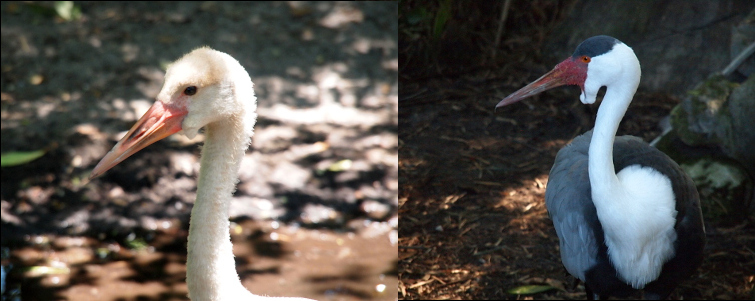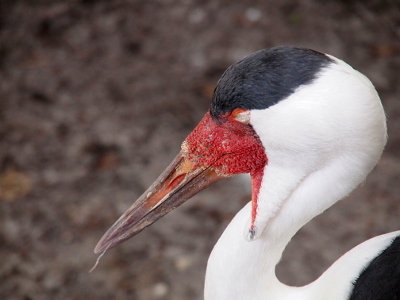Jacksonville Zoo and Gardens - Jacksonville, Florida
Page 10 of 13
- - - - - - - - - - - - - - - - - - - - - - - - - - - - - - - -
The birds on this page and the next were in various exhibits or enclosures throughout the zoo.
A Masai ostrich has only two toes, but they look like hooves. It's no wonder they can run so fast.
![[A front view of the entire ostrich. Both eyes are visible as it looks straight ahead. It has white feathers in a ring around its neck and hanging down from its wings. The body is a dark brown and the neck, head, and legs are pink. The one toe is much larger than the other, but both are large. It has knobby knees.]](Photo/JAXZoo/ostrich 2.jpg)
The emu is the second-largest bird on earth and has red eyes and quite an interesting ear. (Ostrich is the largest bird.)
![[Right side of the face and neck of an emu behind a wire fence. Its mouth is partially open and its eyelid is covering the lower third of its eyeball. The ear is a circular hole behind the mouth and eye. The feathers on its head and neck are so short that they look more like fur.]](Photo/JAXZoo/20160615 - emu 1.jpg)
The emu has beautiful feathers.
![[Two emus, facing the camera, are on the ground resting. Their feathers on their body appear similar to a person's head who's hair has been parted down the center. The feathers appeart to have a part down the spine of the bird and the feathers fall at different levels down the sides.]](Photo/JAXZoo/20160804 - emus 1.jpg)
The third-largest bird is the southern cassowary which is native to Australia.
![[A close view through a fence of the head of this colorful, almost prehistoric-looking, creature. This bird has a large wedge-shaped horn-like protrusion on the top of its head. This bird has a blue head and neck, a red-orange eye, a red patch on the back of its neck near its black-feathered body. Its feathers are similar to the emu with the part down the back and the feathers falling to the side. ]](Photo/JAXZoo/20160804 - southern cassowary 2.jpg)
The feet of the southern cassowary
![[A close view through a fence of the head of the thick three-toed feet of this bird. Each toe has pointed claws. The grey-brown skin of the toes and lower legs are scaley like reptile skin.]](Photo/JAXZoo/20180125 - southern cassowary 2.jpg)
Marabou stork
![[This long-legged bird stands on a log on the grass. Its legs, underside, and part of its upper back are white. The rest of the back is black with a row of short white stripes down the side. Its head is red and as its pouch under its neck.]](Photo/JAXZoo/20160804 - Marabou stork.jpg)
Marabou stork snoozing.
![[This long-legged bird sits on the grass. Its legs fold in the reverse direction of a human's legs and its feet and knees are on the ground. Its head is tucked into its body with its bill resting on its full gullet and its eyelid, a much lighter color than the rest of its head, closed. ]](Photo/JAXZoo/20180125 - Marabou stork.jpg)
Sandhill crane
![[This image is the head and torso of the bird. Its head is facing right showing its long pointed bill. Its head has a red patch above the eye and a white one below it. The rest of the body is grey.]](Photo/JAXZoo/sandhill crane.jpg)
Whooping crane
![[This image is the head and upper neck of the bird. Its head is facing left showing its long pointed bill. The front half of its head is a reddish-black and extend in a c-shape around the eye to the back of its head. The rest of the head and neck of the bird is white. ]](Photo/JAXZoo/20160615 - whooping crane.jpg)
Wattled crane youngster and adult

Wattled cranes have white eyelids.

American flamingos squabbling with each other.
![[Two of the four flamingos face off with each other. The one on the left has its neck completely straight as it leans toward one near it. The other one has its neck in an ess-shape. The flamingos are shades of light and dark pink. Their curved bills are white and pink with a black section on the tip.]](Photo/JAXZoo/flamingo.jpg)
Lot of neck-folding to be done for a American flamingo to tuck its bill under a wing.
![[Three flamingos in a row from front to back of the image and all three have their bills completely tucked in their feathers. The one in the back has its eyes close, but the other two are peeking out above their feathers.]](Photo/JAXZoo/20160804 - Caribbean flamingo 1.jpg)
Greater flamingos (a different breed hence the different coloring)
![[These birds are mostly white with pink bills and legs and a few orange feathers and black feathers on their hind ends. This image is a close view of one on the edge of a group of birds.]](Photo/JAXZoo/20160804 - greater flamingos 1.jpg)
Young greater flamingo has yet to develop its full pink colorings.
![[Flamingo is walking in the water from left to right with only a few inches of legs visible. Its body is mostly white with a few pink feathers on its hind end. Its bill has a black tip, but the rest is white unlike the mature flamingos which have pink and black bills.]](Photo/JAXZoo/20190925 - greater flamingo youngster.jpg)
The legs on a Greater flamingo really fold flat.
![[The main flamingo in the image sits on the ground with the two halves of its legs completely parallel to each other and the ground. Its feet are also spread flat and they and the legs are nearly completely under the bird--only the back knees are easily seen. The flamingos white neck and head is curved into an ess shape. Its bill is bright pink.]](Photo/JAXZoo/20170919 - greater flamingo.jpg)
Lappet-faced vulture
![[The bird faces the camera with its head turned to the right. Its eye is looking at the camera. Its pinkish bald head has a folded-skin look at the top and around the neck. It has an ear opening which is rimmed in brown and seems to protrude a bit from its head. It has a large hooked bill of which the outer part is black, but the part closest to the head is grey. It has some white feathers mixed in with mostly brown ones.]](Photo/JAXZoo/20160804 - lappet-faced vulture 4.jpg)
Lappet-faced vulture looks like it's wearing white bloomers.
![[The bird stands amid some vegetation stumps. There is a puffy white covering leading from the body of the bird to just above its ankles. It has large white claws. The body of the bird is mostly dark brown, but there are some white feathers. Its head is light pink which constrasts with its dark eyes and large dark hooked bill.]](Photo/JAXZoo/20180125 - lappet-faced vulture 2.jpg)
Continue to more bird exhibits. (page 11 of 13)
All photos © S. M. Garver